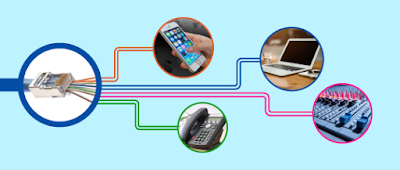These days virtually everyone is talking about Internet Protocol (IP), the standard encoding scheme for sending audio and video files (as IP packets), either over the Internet directly or over an Ethernet-based CAT5/6 cabling network. The cable itself is favored because it is much smaller and lighter and therefore much easier to work with when building new A/V facilities. But where did the IP scheme as we know it today come from?
WHAT IS TCP/IP?First, we have to look at Transmission Control Protocol/Internet Protocol (TCP/IP), which basically describes a protocol that will work on any sort of computer and operating system for transportation of packets of data across the internet or studio network between different systems.

Early concepts of packet networking were developed at several different research labs in the US and overseas, initially for military use. In the late 1970's, a set of networking protocols that allowed two or more computers to communicate, known as TCP/IP, were developed by The Defense Data Network, part of the Department of Defense, for widespread industry use across its Advanced Research Projects Agency Network (ARPANet). ARPANet was an early packet switching network and the first network to implement the protocol suite known as TCP/IP. Soon, several other TCP/IP prototypes were developed at multiple research centers between 1978 and 1983. However, the migration in the US of the ARPANet to TCP/IP was officially completed on January 1, 1983, when the new protocols were permanently activated across what has since become the World Wide Web.
For production professionals, TCP/IP has become very important to audio file delivery and networking because it allows the flexibility to route resources to any part of a facility (or remote location) from a centralized position. It also facilitates the development of Audio-over-IP (AoIP) networks that allow convenient control and monitoring of equipment and systems, and the rapid transfer of audio and firmware files between components.INFORMATION OVERLOADWith the use of TCP/IP, the amount of information a single cable can carry has increased from a few thousand bits per second in the 1960's to a few billion bits per second today. Regular affordable connections in every day information systems now carry one or more gigabits of information in a single fiber cable over distances spanning many miles. This bandwidth is enough to transport hundreds of high quality audio channels, replacing hundreds of pounds of cabling in conventional systems. More importantly, the functional connections in a networked audio system can be designed separately from the physical connections in the network, due to the flexibility of the IP scheme.

The functionality opens up a wide array of exciting possibilities for the audio industry: any number of I/O locations can connect to the network anywhere in the system without the limitations of bulky cables, leaving the actual connections to be managed with easy-to-use software. Control signals can be included in the network without additional cabling. Computers can use the network to control and monitor audio devices, such as digital mixers and DSP engines. Video connections can also be included using affordable IP-controlled cameras. IP is allowing users to send high-quality audio feeds over long distances. This is also known as Audio Contribution over IP (ACIP), which enables programming contributions from outside members of the team as if they were in the next room.CHANGING THE WAY YOU COMMUNICATEClearly, the Internet and IP have changed the way audio production is performed across a wide variety of applications. Time and space limitations are no longer valid. Professional productions now benefit from the ability to bring in all types of sources from a variety of disparate locations to support and control an array of devices.The inevitable merging of computer networking technology and audio distribution has arrived. It's time to re-examine the assumptions and concerns (eg, latency, security, etc.) that are holding some professionals back from choosing Audio-over-IP solutions and just get on with it. IP packets can be easily sent and received in a variety of ways that help streamline workflows of all types. It also potentially enables more productivity with less people.

Early AoIP networks were plagued with dropouts, pops and clicks, with most devices limited to a paltry 10 Mbps bandwidth. Some thought that IP packets were never going to be fast enough to deliver real-time audio. With modern advances in networking connectivity, now we know you can.Network speed is no longer a practical limiting factor. Gigabit speeds and modern switching technology ensure virtually zero packet loss under real life conditions in copper or fiber optic networks, while providing ample bandwidth for hundreds of channels of audio and other data at each node. Switched networks isolate traffic at each port, permitting thousands of channels to exist without conflict on a single network without dropouts or errors. MOVING FORWARDThe effect that the Internet Protocol has had on today's audio professional cannot be overstated. TCP/IP ensures that data will get to the correct destination and received in the correct order. We're living in a time of massive online growth. IP has helped make sense of it all and, really, saved the day by making our lives a whole lot easier. And the best part: an IP network will be relevant and easily upgradable for years to come.
Related Articles ---------